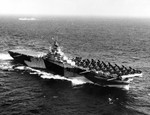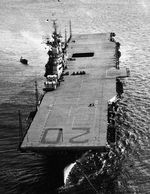Bennington
| Country | United States |
| Ship Class | Essex-Class Aircraft Carrier |
| Hull Number | CV-20 |
| Builder | New York Navy Yard |
| Laid Down Date | 15 Dec 1942 |
| Launch Date | 26 Feb 1944 |
| Commission Date | 6 Aug 1944 |
| Decommission Date | 8 Nov 1946 |
| Displacement | 27,100 tons standard; 36,380 tons full |
| Length | 872 feet |
| Beam | 147 feet |
| Draft | 29 feet |
| Machinery | Eight boilers, four Westinghouse geared steam turbines, four shafts |
| Bunkerage | 6,330t fuel oil; 240,000gal aviation fuel |
| Power Output | 150,000 shaft horsepower |
| Speed | 33 knots |
| Range | 20,000nm at 15 knots |
| Crew | 3,448 |
| Armament | 4x2x5in 38cal guns, 4x5in 38cal guns, 10x4x40mm 56cal guns, 60x20mm 78cal guns |
| Armor | 2.5 to 4in belt, 1.5in hangar and protective decks, 4in bulkheads, 1.5in STS top and sides of pilot house |
| Aircraft | 90-100 |
| Elevators | 3 |
Contributor: David Stubblebine
ww2dbaseOf the seventeen Essex-class aircraft carriers to be commissioned during World War II, USS Bennington was the eleventh. Built at the New York Navy Yard in Brooklyn, New York, United States, Bennington was built according to the original Essex specifications rather than the updated long-hull design used at Newport News, Virginia and Quincy, Massachusetts. As such, Bennington was the ninth of the ten short-hull Essex-class carriers.
ww2dbaseLaunched 26 Feb 1944 and commissioned 6 Aug 1944, Bennington put to sea for her shakedown cruise to Trinidad on 16 Oct 1944. After a brief return to the United States, Bennington departed for the Pacific 21 Dec 1944 and joined the fleet at Ulithi 8 Feb 1945. Two days later, Bennington sailed with the most formidable American fleet yet assembled, 16 aircraft carriers and over 100 escorting vessels. Bennington’s first day of combat came on 16 Feb 1945 against targets in Japan itself in what were the first carrier-based air attacks on Japan since the Doolittle Raid three years before.
ww2dbaseBennington aviators spent two days attacking targets around Tokyo and at the Yokosuka naval base. Due to poor weather, the Task Force withdrew to the south where they launched four days of direct support strikes on Iwo Jima to aid the Marines on the ground. On 25 Feb 1945, Bennington and the carrier force returned to the Tokyo area for one day. The fleet then made one attack on the installations on Okinawa on 1 Mar 1945 before returning to Ulithi.
ww2dbaseBennington and the fleet put to sea again in mid-Mar 1945 to launch air strikes in preparation for the landings on Okinawa, which took place on 1 Apr 1945. Bennington remained active in support of the Okinawa operation for most of that month and the next, except for one day on 7 Apr 1945 when all of the fleet’s air resources were diverted toward the sea. US submarines reported the Japanese super-battleship Yamato was closing from the north. Bennington aviators lost only one airplane in that attack and claimed at least two torpedo hits against the battleship before she exploded.
ww2dbaseIn Jun 1945, Bennington and the fleet steamed through a typhoon southeast of Japan. In the 60-knot winds and heavy seas, the leading twenty-five feet of Bennington’s flight deck buckled and was left collapsed over the bow. Several of the work stations and equipment stored around the edge of the flight deck were also carried away, but there were no casualties. Bennington retired to San Pedro Bay off Leyte in the Philippines for repairs.
ww2dbaseAfter those repairs were completed, Bennington sailed with the fleet again on 1 Jul 1945 to concentrate exclusively on targets the Japanese home islands and surrounding waters. Her planes ranged the length of the island chain, flying with virtual impunity over Japan. She was still conducting these strikes on 15 Aug 1945 when Japan surrendered and all offensive action stopped. Bennington continued operations around Japan, conducting routine patrols and searches for Allied prisoners of war camps. On 10 Sep 1945, Bennington entered Tokyo Bay.
ww2dbaseThe aircraft carrier remained in the western Pacific until mid-Oct 1945 when she returned to the United States. She made a few support sorties before repositioning to the east coast in early Apr 1946. She was decommissioned at Norfolk, Virginia on 8 Nov 1946 and berthed with the Atlantic Reserve Fleet.
ww2dbaseOn 29 Oct 1950, Bennington moved to the New York Naval Shipyard to be modernized and prepared for active service again. This took two years and she was recommissioned on 13 Nov 1952. Bennington had survived the last six months of World War II with barely a scratch, and this was during the period of the greatest peril for the carriers due to the special attacks ("kamikaze" attacks) that were so prevalent around Okinawa. In peace, however, Bennington would not be so lucky. During her recommissioning shakedown cruise, Bennington suffered an explosion in her Number 1 fireroom that rocked her lower decks and claimed the lives of 11 men, but prompt action by the damage control team minimized the damage. She put into Guantanamo Bay, Cuba, completed repairs, and returned to sea.
ww2dbaseBennington conducted normal operations with the Atlantic Fleet before moving to the Mediterranean for a year. After a return to the United States, Bennington was off Rhode Island conducting carrier qualifications on 26 May 1954 when the port side hydraulic catapult exploded, releasing a large volume of hydraulic oil under high pressure that immediately ignited. As fires raged, she made her way to Quonset Point while damage control parties worked to control flames and rescue the injured. 103 officers and men were killed and over 200 others were injured, most of them severely burned.
ww2dbaseOnce the injured men were transferred to hospitals, Bennington headed to New York for extensive repairs. The shipyard took this opportunity to make major modifications originally scheduled for a later date. The two most notable changes were the addition of an enclosed hurricane bow to lessen the potential for damage in heavy weather and the installation of an angled flight deck to improve the efficiency of air operations.
ww2dbaseAfter repairs and alterations were completed, the carrier returned to sea on 25 Apr 1955 to conduct normal operations along the east coast and in the West Indies. On 8 Sep 1955, Bennington departed for a new home port. Steaming around Cape Horn, she arrived in San Diego, California and joined the Pacific Fleet. Over the next nine years, Bennington divided her time between both sides of the Pacific Ocean, including five deployments to the Orient. During this period in 1959, Bennington’s mission was adjusted to be exclusively for antisubmarine warfare. Beginning in 1964, Bennington made a series of deployments into Vietnamese waters as that conflict was heating up. In May 1967, Bennington was in Sydney, Australia to commemorate the 25th anniversary of the Battle of the Coral Sea. She then returned to California for a year, made one more deployment to the western Pacific, and entered the Long Beach Naval Shipyard for a five-month yard overhaul. After just a year of operations off the California coast, Bennington was taken out of commission for the last time on 5 Jan 1970 and placed in the Pacific Reserve Fleet at Puget Sound Naval Shipyard, Bremerton, Washington. The ship was scrapped in 1994.
ww2dbaseBennington earned three battle stars in World War II (Iwo Jima; Okinawa; 3rd Fleet Operations against Japan) and five battle stars during the Vietnam conflict. Among her other awards were two Navy Meritorious Unit Commendations, the China Service Medal (Extended), World War II Victory Medal, Navy Occupation Service Medal with 'Asia' clasp, two National Defense Service Medals, and two Armed Forces Expeditionary Medals.
ww2dbaseSources:
United States Navy
Dictionary of American Naval Fighting Ships
United States National Archives
NavSource Naval History
USS-Bennington.org
Bennington veteran Jack Douglas Rich
Wikipedia
Last Major Revision: May 2020
Aircraft Carrier Bennington (CV-20) Interactive Map
Photographs
 |  |  |  |
Videos
 |
Bennington Operational Timeline
| 15 Dec 1942 | USS Bennington was laid down, New York Navy Yard, Brooklyn, New York, United States. |
| 26 Feb 1944 | USS Bennington was launched, New York Navy Yard, Brooklyn, New York, United States. |
| 6 Aug 1944 | USS Bennington was commissioned, New York Navy Yard, Brooklyn, New York, United States. |
| 21 Dec 1944 | USS Bennington transited the Panama Canal. |
| 8 Feb 1945 | USS Bennington joined the US 5th Fleet at Ulithi, Caroline Islands. |
| 16 Feb 1945 | USS Bennington launched her first offensive strikes of the war against targets around Tokyo and Yokosuka, Japan. |
| 4 Jun 1945 | Many ships from the United States Third Fleet, primarily Task Groups 38.1 and 30.8 sailed into Typhoon Connie south of Japan. No ships were lost but 7 men lost their lives. |
| 5 Jun 1945 | As the US 3rd Fleet steamed through a typhoon southeast of Japan, the leading 25-feet of USS Bennington's flight deck collapsed and hung drooping over her bow. |
| 8 Nov 1946 | USS Bennington was decommissioned at Norfolk, Virginia, United States. |
| 13 Nov 1952 | USS Bennington was recommissioned at New York Navy Yard, Brooklyn, New York, United States. |
| 27 Apr 1953 | While steaming in the Caribbean, USS Bennington suffered an explosion in her No. 1 fire room that killed 11 men. |
| 26 May 1954 | While steaming off Rhode Island, USS Bennington's port catapult exploded releasing hydraulic oil under high pressure that instantly ignited. 103 officers and men were killed while over 200 more were badly injured, most with severe burns. |
| 15 Jan 1970 | USS Bennington was placed out of commission for the last time at Bremerton, Washington, United States. |
| 12 Jan 1994 | The ex-USS Bennington was sold for scrap. |
Please consider supporting us on Patreon. Even $1 per month will go a long way! Thank you. Please help us spread the word: Stay updated with WW2DB: |
Visitor Submitted Comments
13 Dec 2021 02:42:58 PM
my cousin Lieutenant James Carroll was shot down Feb 16 1945 over Tokyo. A parachute was spotted but it was found after the war he did not survive the day in captivity.
All visitor submitted comments are opinions of those making the submissions and do not reflect views of WW2DB.

» Battle of Iwo Jima
» Okinawa Campaign
» Typhoon Connie
» Preparations for Invasion of Japan
» Japan's Surrender
Document(s):
» US Aircraft Carrier Functions
» US Aircraft Carrier Operational Status By Month
» US Carrier Time Operational
 |
- » 1,182 biographies
- » 337 events
- » 45,115 timeline entries
- » 1,248 ships
- » 350 aircraft models
- » 207 vehicle models
- » 376 weapon models
- » 123 historical documents
- » 261 facilities
- » 470 book reviews
- » 28,413 photos
- » 365 maps
Winston Churchill
Please consider supporting us on Patreon. Even $1 a month will go a long way. Thank you!
Or, please support us by purchasing some WW2DB merchandise at TeeSpring, Thank you!
15 May 2020 03:10:47 AM
Thank you, David, I enjoyed reading this article.